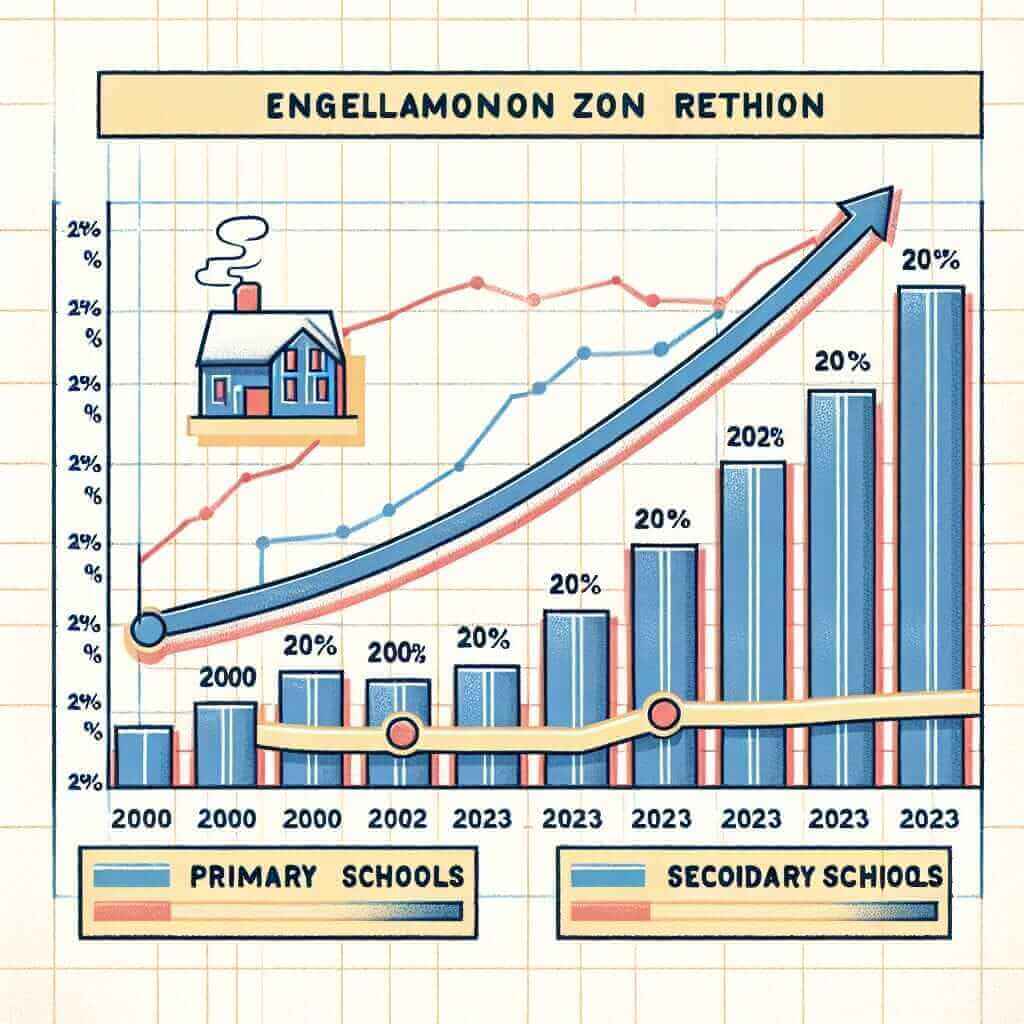Understanding trends in educational enrollment is crucial not only for policy makers but also for education professionals, researchers, and students preparing for the IELTS exam. In this article, we will delve into the changing patterns of enrollment rates in primary and secondary schools from 2000 to 2023. This topic can often appear in IELTS Writing Task 1, particularly in the form of line graphs, bar charts, or tables. We will also cover relevant vocabulary, grammatical structures, and essential strategies that can help you score high in the IELTS exam.
Exploring the Topic: Enrollment Rates in Primary and Secondary Schools (2000-2023)
Potential IELTS Writing Task 1 Prompts
- Line Graph: The line graph below shows the enrollment rates in primary and secondary schools from 2000 to 2023. Summarize the information by selecting and reporting the main features, and make comparisons where relevant.
- Bar Chart: The bar chart below illustrates the enrollment rates in primary and secondary schools over a 23-year period from 2000 to 2023. Summarize the information by selecting and reporting the main features, and make comparisons where relevant.
- Table: The table below presents data on the enrollment rates in primary and secondary schools in various countries between 2000 and 2023. Summarize the information by selecting and reporting the main features, and make comparisons where relevant.
Data Representation: Enrollment Rates
Table Example:
| Year | Primary School Enrollment (%) | Secondary School Enrollment (%) |
|——|——————————-|———————————|
| 2000 | 75% | 50% |
| 2005 | 80% | 60% |
| 2010 | 85% | 65% |
| 2015 | 90% | 70% |
| 2020 | 92% | 75% |
| 2023 | 94% | 80% |

Analysis of the Prompt
Analyzing the data, we can observe a steady increase in enrollment rates both in primary and secondary schools from 2000 to 2023. It is essential to note the differences in the trends between the two types of education levels and to highlight significant changes over the years.
Sample Answer: Analyzing Enrollment Data
The table illustrates the enrollment rates in primary and secondary schools over a span of 23 years, from 2000 to 2023. Overall, the data shows a consistent rise in the percentage of enrollments for both educational levels.
In 2000, the primary school enrollment rate was 75%, which increased to 80% by 2005. This upward trend continued, reaching 85% in 2010 and 90% in 2015. By 2020, the enrollment rate for primary schools had risen to 92%, and it peaked at 94% in 2023.
Similarly, the secondary school enrollment rates also showed significant growth. Starting at 50% in 2000, the percentage rose to 60% by 2005. This steady growth persisted throughout the years, with enrollment rates climbing to 65% in 2010 and 70% in 2015. By the year 2020, secondary school enrollment had reached 75%, finally achieving 80% by 2023.
In conclusion, the data indicates that both primary and secondary school enrollments have experienced consistent and significant increases from 2000 to 2023, reflecting improvements in the accessibility and quality of education over these years.
(Word count: 189)
Key Points to Remember When Writing
- Identification of Trends: Clearly identify and explain trends.
- Compare Data: Make relevant comparisons between different years and education levels.
- Use of Vocabulary: Employ a range of vocabulary to describe trends, such as “increase,” “rise,” “growth,” “steady,” “significant,” etc.
- Accurate Grammar: Ensure grammatical accuracy, particularly in the use of past and present perfect tenses.
- Clear Structure: Follow a clear structure with an introduction, main body, and conclusion.
Advanced Vocabulary and Key Grammar
Vocabulary
- Enrollment (noun) /ɪnˈrəʊlmənt/: the number of individuals enrolled in an institution or level of education.
- Steady (adjective) /ˈstedi/: maintaining a constant rate of change.
- Significant (adjective) /sɪɡˈnɪfɪkənt/: noticeably large in size or importance.
- Consistent (adjective) /kənˈsɪstənt/: unchanging in nature over a period of time.
- Accessibility (noun) /əkˌsesəˈbɪlɪti/: the quality of being easy to obtain or use.
- Peaked (verb) /piːkd/: reached the highest point.
Grammar
- Present Perfect: Used to discuss trends that began in the past and continue into the present. E.g., “enrollment rates have risen.”
- Past Simple: Used to describe completed actions or events. E.g., “In 2000, the enrollment rate was 75%.”
- Comparison Structures: Phrases such as “compared to,” “in contrast to,” “similarly,” etc.
Conclusion
In summary, when tackling an IELTS Writing Task 1 concerning enrollment rates in primary and secondary schools, it’s essential to accurately describe and compare the data, use relevant vocabulary and grammar, and structure your essay clearly. By mastering these components, you can aim for a Band 7+ score in your IELTS exam.